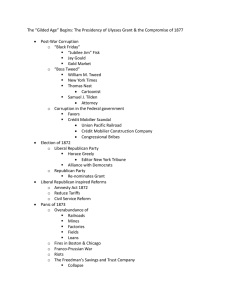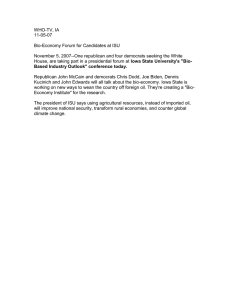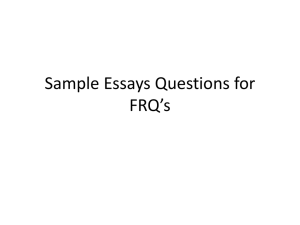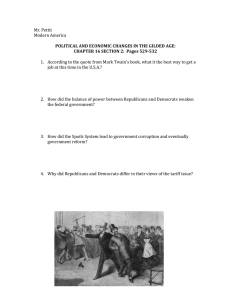“CHANGE” A History of the Political Parties of the United States... By: Matt Leung Celso Leite
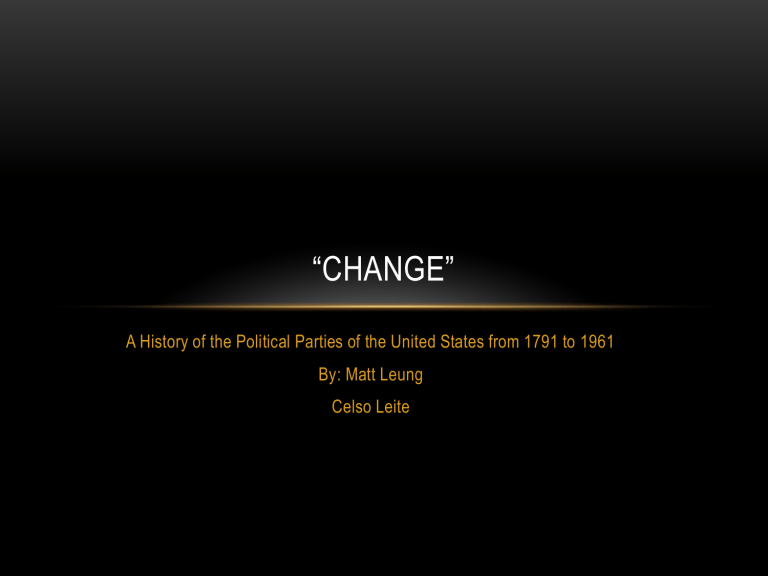
“CHANGE”
A History of the Political Parties of the United States from 1791 to 1961
By: Matt Leung
Celso Leite
THESIS
• Since their inception, both the Democratic Party and the Republican Party of the United
States have undergone significant ideological shifts on the left-right spectrum from 1840 to the 1960.
• Whereas an ideology that is center-left is defined as an ideology, which supports the use of governmental regulation to achieve social justice and whereas an ideology that is center-right is an ideology, which supports tradition and free enterprise.
WASHINGTON’S WARNING
In his farewell address in 1791, Washington warned of the dangers of political parties
Believed that parties would split the Union and create other political loyalties
Removal of political parties could allow people to remain more loyal to the community, state, and nation
Recognized their ability to protect against monarchy
Could distract government from duties because of various jealousies
Left
Center-
Left
Center
Center-
Right
Right
FORMATION OF THE DEMOCRATIC PARTY
Party evolved from the opposition of fiscal policies of Alexander Hamilton
Built off of the failing Democratic-Republican Party
Ideologically began with the founding of the Democratic-Republican Party in 1791
Officially began with Andrew Jackson’s nomination for Democratic presidential candidate for the election of 1832
Democratic-Republican Party did NOT split into the Democratic Party and
Republican Party
First Mass party
Small government
Andrew Jackson was the first Democratic Party president
Left
Center-
Left
Center
Center-
Right
Right
EARLY DEMOCRATIC PARTY
Jacksonian Democrats
Ideology revolved around speaking for the common man and watching out for their interests
Party represented those that were not wealthy planters, merchants, and lawyers
Protection of common man and his liberties
Suspicious of elitism
Faith placed in masses for governmental responsibility and power
Suffrage to more men
Left
Center-
Left
Center
Center-
Right
Right
EARLY DEMOCRATIC PARTY
Did not mind a strong executive
Jacksonian era Democrats were dominated by Jackson during his presidency and gave him little opposition
Against central financial institution (Bank of the United States)
Policy against the “aristocratic banks”
Small government = good
No religion in politics
Appealed to immigrants
Left
Center-
Left
Center
Center-
Right
Right
IMMEDIATE PRE-CIVIL WAR DEMOCRATS
Divided on certain issues from sectionalism
Northern Democrats
Remained firm on a few ideologies
Supported immigrants
Support for immigrants led to the death of the Whig Party and had a part in creating the Republican Party
SECTIONALISM
STATES RIGHTS
By 1860, the party was nearly fully divided with the majority in the Southern Democrats
States Rights led to Civil War
Left
Center-
Left
Center
Center-
Right
Right
FORMATION OF THE REPUBLICAN PARTY
Ideology
Party evolved from Whig policy and adoption of Freesoiler ideals
Began with the combination of the Whig Party and a faction of the Democratic Party
Ideologically formed as “Republicans” on March 20, 1854
Officially began with John C Frémont’s nomination for Republican presidential candidate for the election of 1856
Economic policy formed off of existing Whig policy
Protectionism
Protestant values
Abraham Lincoln was the first Republican Party president
Left
Center-
Left
Center
Center-
Right
Right
RECONSTRUCTION ERA DEMOCRATS
Party mostly destroyed by direct administration by federal military governments
Focus on rebuilding shattered party rather than promoting a single, unified ideology
Drew in resentful white Southerners
Resentment channeled toward freed blacks
Party became one that held three main ideas, the South, segregation and White
Supremacism
Johnson issued policies that promoted segregation and supported South
Amnesty
Led to rebuilding antebellum government and black codes
Left
Center-
Left
Center
Center-
Right
Right
RECONSTRUCTION REPUBLICAN PARTY
At founding, it was a pro-business, pro-bank, pro-tariff, and pro-gold standard
Radical Republicans grew at the end of the Civil War for more progressive measures during Reconstruction moving to the center left
Attempted to gain votes from carpetbaggers, Freedmen, and Scalawags
Grew extremely large in size from popularity
Appealed to nearly all social statuses
Larger size made factional splits inevitable
Left
Center-
Left
Center
Center-
Right
Right
RECONSTRUCTION REPUBLICAN PARTY
The large party was threatened to break by the contrary opinions of different factions
Corruption during the Grant Presidency by his Cabinet and others hastened the process
Whiskey Ring – hypocrisy
During this time, multiple founders of the Republican Party decided to shift to a further center-left standpoint
Civil Rights became a volatile issue
Supported increased Civil Rights
Freedmen’s Bureau
Large splits and divisions leading up to and during the Gilded Age
Left
Center-
Left
Center
Center-
Right
Right
GILDED AGE DEMOCRATS
Two distinctive ideologies
Bourbon Democrats
Backed Grover Cleveland
Returned to Jackson’s idea of a “hands off” policy
Progressive Democrats
End of the Gilded Age
Dominated the party during the beginning of the 20 th century
Left
Center-
Left
Center
Center-
Right
Right
GILDED AGE REPUBLICAN PARTY
3 major factions – split over business and Civil Rights
Stalwarts – Defended Spoils System
Half-breeds – Wanted reform of Civil Service
Mugawumps – Completely rejected Spoils System
During the Gilded Age, Northern business boomed
Republicans tended to support big business ventures, including the Gold Standard and high tariffs
Additionally supported pensions for war veterans
Left
Center-
Left
Center
Center-
Right
Right
PROGRESSIVE ERA REPUBLICAN PARTY
Agreed to the Sherman Anti-Trust Act and Interstate Commerce Commission
Hurt by the high McKinley Tariff
Supported Prohibition
Clearly defined religious background
Won the 1894 election in the biggest landslide in history, after Democrats were blamed for the Depression of 1893
Left
Center-
Left
Center
Center-
Right
Right
PROGRESSIVE ERA REPUBLICAN PARTY
Environmental issues led to passing of Newlands Reclamation Bill
Began the Square Deal
“Trust busting”
43 actions by the time TR left office
99 prosecutions by the time Taft left office
Input in labor disputes
Assisted with anthracite coal strike
Left
Center-
Left
Center
Center-
Right
Right
PROGRESSIVE ERA REPUBLICAN PARTY
Expansionist (Hawaii)
Imperialistic policies that thrust America into the world
Dynamic foreign policy, created a new government in Philippines
Financed revolution in Panama to gain support for the Canal there
Roosevelt Corollary to Monroe Doctrine
Left
Center-
Left
Center
Center-
Right
Right
PROGRESSIVE DEMOCRATS
Wilsonian Democrats
Fight for the common man
Supported policies against the banks
Fought against those who made too much money during the Gilded Age
Fought the “American Aristocracy”
•
•
• To deal with big business they supported
Busting of good and bad trusts in order to protect small businessmen
Lowering tariff rates to stop protecting big American corporations
Left
Center-
Left
Center
Center-
Right
Right
PROGRESSIVE DEMOCRATS
• Regulations that would protect labor unions from trust busting
•
• To deal with big banks the Wilsonians supported a complete overhaul of the banks
They established a much more centralized banking system under the FED
•
•
• The head of which would be appointed by the President of the United States
• To deal with the actual “monied” aristocracy
They enacted a progressive income tax system
Allowed the government to impose selective tax rates so as not to harm the
“common man”
Left
Center-
Left
Center
Center-
Right
Right
HOOVER ERA REPUBLICAN PARTY
Hoover elected president
Strong center-right policy
Stock Market crash led to Great Depression
Republican policy stayed conservative in a hands off governmental policy
Relied on local level to rectify the poverty
“Rugged Individualism”
Kept government out of nation’s economic problems
When it became obvious that government intervention was required, innovative counteraction programs were implemented
Left
Center-
Left
Center
Center-
Right
Right
NEW DEAL DEMOCRATS
Dominated by the policies of FDR
Supported government regulation of corporations and big banks
• They created regulatory agencies such as the Exchanges Commission
• They required banks to pay into the FDIC insurance
• They supported the regulation of oil prices and pipeline construction
• Increasing the amount of tax the upper class was required to pay
Left
Center-
Left
Center
Center-
Right
Right
NEW DEAL DEMOCRATS
Believed government should also regulate employment and social stability
• The expansion of the eminent domain and state seizure for public works
• Employing people in public works
• The regulation of employee working hours and wages
• Regulation increasing the protection afforded to labor unions
• Establishment of a social security net for the lower classes
Left
Center-
Left
Center
Center-
Right
Right
REPUBLICAN PARTY (EISENHOWER
PRESIDENCY)
Dynamic Conservatism
Continued and expanded remaining New Deal policies
Pro-tradition
Expanded Social Security and built Interstate Highway System
Keep Federal government in some areas while moving them out of others
Increased domestic and defense spending
Objectives included balancing budget and anti-communism
Foreign affairs were limited to limiting the spread of communism and adherence to UN
Kept United States out of major foreign conflicts despite Cold War tensions
Attempted to keep peaceful terms with all nations instead of becoming a belligerent in foreign affairs
Left
Center-
Left
Center
Center-
Right
Right
CONCLUSION
Left
End
Center-
Left
Democrats
Start
Center
Center-
Right
Right
Left
Start
Center-
Left
Republicans
Center
End
Center-
Right
Right
